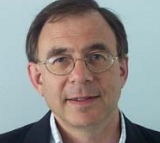

The 2013 Nobel Prize in Chemistry has been awarded today. Researchers at Imperial tell us how the discoveries have sped up research in the field.
Awarded to Martin Karplus, Michael Levitt and Arieh Warshel, the Prize recognises three scientists for the development 'of multiscale models for complex chemical systems'.
During the 1970s they made major advances in computer modelling in chemistry. These made it possible for the first time to simulate chemical reactions at great speed, and to predict what effect these reactions will have in biological systems, such as the cells of our bodies.
Previously, scientists studying complicated reactions, such as the impact of experimental drug molecules in the body, had to make a calculated guess about what might be their most likely effect. Often, finding out the most likely outcomes was very time consuming, and only possible using the most high-powered computers available at the time.
 "I was fortunate to meet Levitt and Warshel when they started their modelling in the mid-'70s and to have spent a few weeks working with Professor Karplus in Harvard. It was clear at the time they were making major advances in computational modelling. Since then many of the approaches they have developed in their research are widely used by computational chemists and biologists," said Professor Mike Sternberg (left) from the Department of Life Sciences at Imperial College London.
"I was fortunate to meet Levitt and Warshel when they started their modelling in the mid-'70s and to have spent a few weeks working with Professor Karplus in Harvard. It was clear at the time they were making major advances in computational modelling. Since then many of the approaches they have developed in their research are widely used by computational chemists and biologists," said Professor Mike Sternberg (left) from the Department of Life Sciences at Imperial College London.
His work as Director of Imperial's Centre for Integrative Systems Biology and Bioinformatics brings together scientists from a wide range of different fields to understand biological problems through a cycle of experimentation and computer modelling.
"They have made major advances in moving chemistry from the test tube to the computer. They developed powerful methods for modelling protein structure and function with high accuracy, by combining classical physics based on Newton's laws of motion with a treatment of quantum mechanics," he continued.
 Dr Ian Gould (pictured left) is Reader in Computational Chemical Biology in the Department of Chemistry at Imperial College London, whose work has built on the foundations laid by the prize-winning trio.
Dr Ian Gould (pictured left) is Reader in Computational Chemical Biology in the Department of Chemistry at Imperial College London, whose work has built on the foundations laid by the prize-winning trio.
He added: "This Prize confirms the indispensible role of modern computer simulation as a tool for investigating atomic structure and function.
"The simulations they developed were the first to be based upon physical models where atoms are represented as connected springs of a finite size and with electrostatic interactions, whereby negatively and positively charged objects attract one another, and two negatives or two positives repel."
Models like this allows scientists to study how chemicals interact with one another over long time periods and predict all the possible outcomes of similar reactions. "This is in a similar manner to how astronomers are able to predict the orbit of planets, comets and asteroids using Newton’s second law of motion," explained Dr Gould.
Professor Sternberg added: "The method developed by Karplus, Levitt and Warshel enables scientists to understand in detail the biology of large proteins and nucleic acids works, and can be used to design new kinds of pharmaceutical drugs, so the influence of this work continues to grow."
Article text (excluding photos or graphics) available under an Attribution-NonCommercial-ShareAlike Creative Commons license.
Photos and graphics subject to third party copyright used with permission or © Imperial College London.
Reporter
Simon Levey
Communications Division

Contact details
Email: s.levey@imperial.ac.uk
Show all stories by this author




Leave a comment
Your comment may be published, displaying your name as you provide it, unless you request otherwise. Your contact details will never be published.